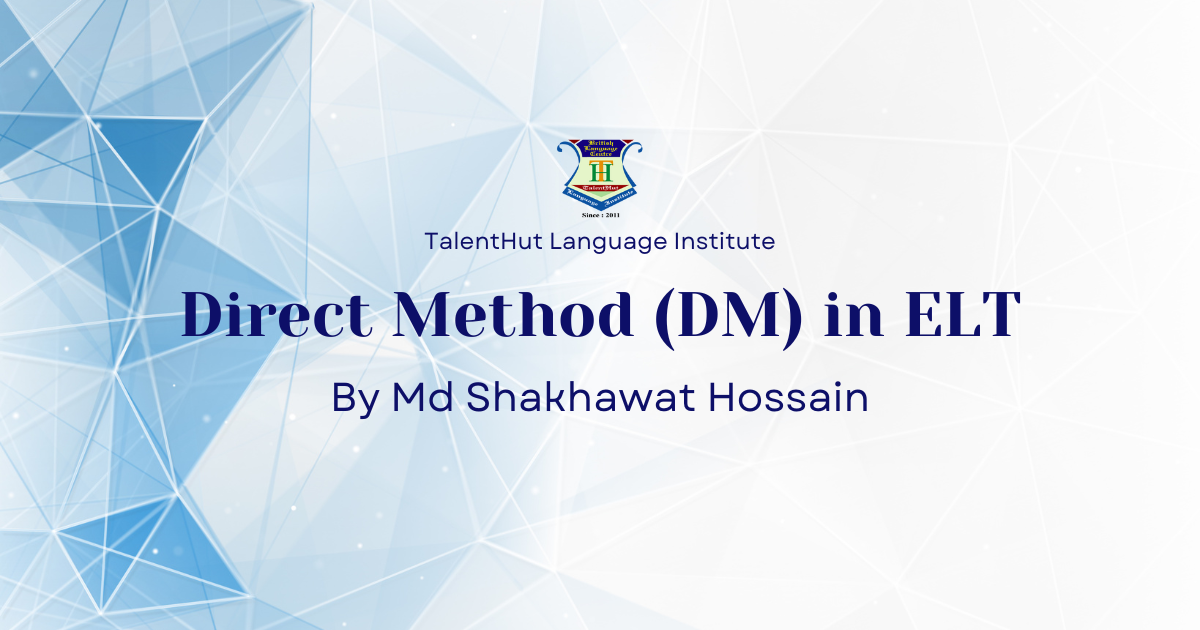The Direct Method (DM) in ELT: Teaching English to ESL Students
ELT Hacks: The Direct Method (DM)
The Direct Method (DM) in English Language Teaching (ELT) is renowned for its emphasis on direct immersion in the target language, avoiding translation and focusing instead on oral communication and inductive learning. This method has gained popularity for its effectiveness in developing speaking and listening skills. In this article, we will explore the principles of the Direct Method, its practical applications, and how platforms like talenthut can effectively use this method to teach English to ESL students.
Understanding the Direct Method
Overview: The Direct Method, also known as the Natural Method, is characterized by teaching language directly through the target language itself, without relying on the student’s native language. It emphasizes everyday vocabulary, sentence structures, and interactive activities to foster a natural language acquisition process.
Key Features:
– Exclusive use of the target language for instruction.
– Emphasis on spoken language and listening comprehension.
– Inductive approach to grammar teaching.
– Use of visual aids, realia, and interactive techniques.
– Focus on question-and-answer patterns to stimulate dialogue.
Practical Applications of the Direct Method
1. Immersive Language Environment
Practical Application: At talenthut, ESL/ELT classes can create an immersive environment where only English is spoken. This can be achieved through the use of simple, clear instructions and encouraging students to communicate exclusively in English. For example, during an introductory lesson, teachers can use visual aids like pictures, flashcards, and objects to teach basic vocabulary without translating. This helps students associate words directly with their meanings, reinforcing language acquisition through context and usage.
2. Interactive Activities
Practical Application: Interactive activities are central to the Direct Method. TalentHut can design lessons that include role-plays, simulations, and real-life scenarios. For instance, in a lesson about shopping, students can engage in a simulated marketplace activity where they practice vocabulary related to buying and selling, asking for prices, and making transactions. These activities not only enhance vocabulary but also build confidence in speaking and listening.
3. Question-and-Answer Drills
Practical Application: The Direct Method heavily relies on question-and-answer drills to practice language structures. In talenthut’s ESL classes, teachers can use this technique to reinforce grammar and vocabulary. For example, during a lesson on past tense, the teacher can ask questions like “What did you do yesterday?” and prompt students to answer in full sentences. This practice helps students internalize grammatical patterns and improves their ability to respond spontaneously.
4. Real-Life Conversations
Practical Application: Engaging students in real-life conversations is a hallmark of the Direct Method. TalentHut can organize conversation clubs or discussion groups where students talk about everyday topics, such as hobbies, travel, or current events. This not only enhances their speaking and listening skills but also makes learning relevant and enjoyable. For example, discussing a recent news article or sharing personal experiences can make lessons more engaging and practical.
5. Visual and Contextual Learning
Practical Application: Using visual aids and context is crucial in the Direct Method. TalentHut can integrate multimedia resources such as videos, images, and real objects into lessons. For example, during a lesson on weather, teachers can use weather charts, videos of different weather conditions, and actual weather reports to teach relevant vocabulary and expressions. This approach helps students understand and remember new words and phrases more effectively.
6. Grammar in Context
Practical Application: Grammar is taught inductively in the Direct Method, meaning students learn rules through exposure and practice rather than explicit instruction. At talenthut, teachers can present grammar points through examples and encourage students to deduce the rules themselves. For instance, instead of explaining the rules of present continuous tense directly, the teacher can provide sentences like “I am eating,” “She is reading,” and “They are playing,” and guide students to observe the pattern and form the rule.
Using the Direct Method for IELTS Preparation
Practical Application: For students preparing for IELTS, the Direct Method can be particularly beneficial in improving speaking and listening skills. TalentHut can offer specialized IELTS preparation courses that incorporate DM techniques. For instance, mock speaking tests can be conducted where students practice responding to common IELTS prompts without relying on their native language. Listening exercises can include real-life conversations, interviews, and lectures to simulate the IELTS listening test environment.
Conclusion
The Direct Method offers a dynamic and engaging approach to teaching English to ESL students. By creating an immersive language environment, utilizing interactive activities, and focusing on real-life communication, platforms like talenthut can effectively use this method to enhance language proficiency. The Direct Method not only improves speaking and listening skills but also fosters a natural and intuitive understanding of the language, preparing students for both everyday communication and academic challenges such as the IELTS exam.
Also read:
The Grammar-Translation Method (GTM)
Contact us:

